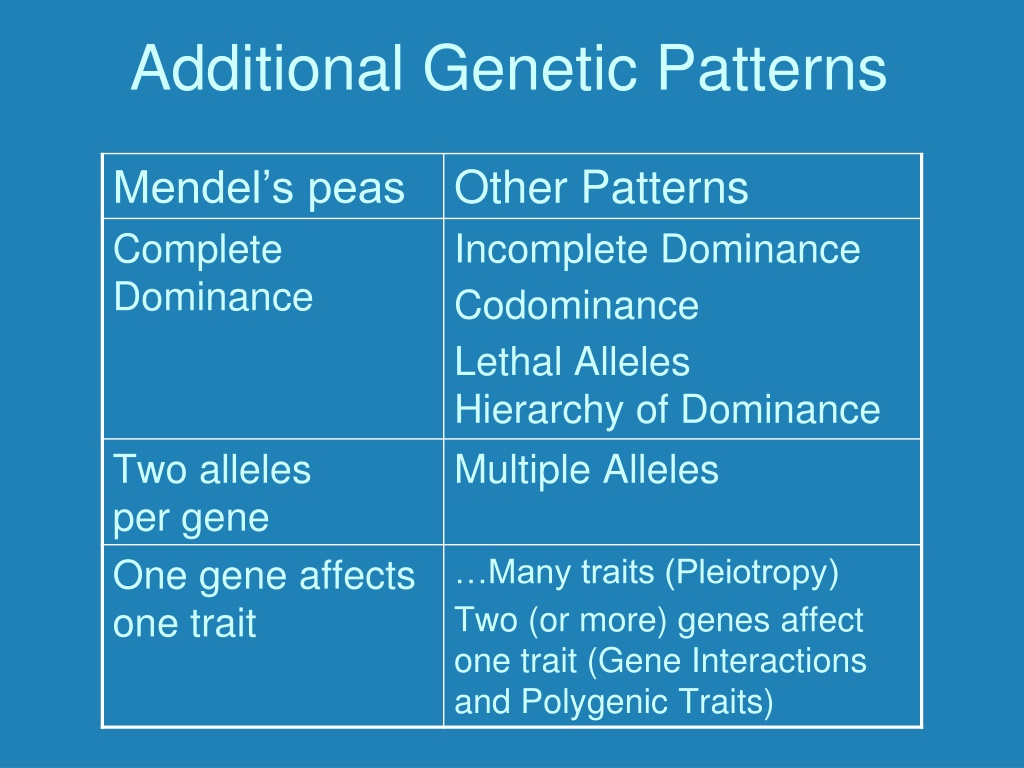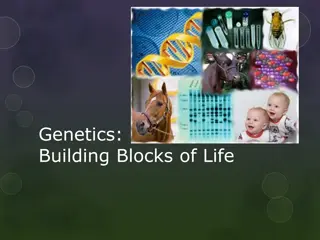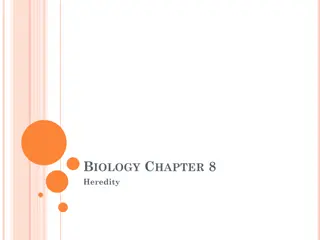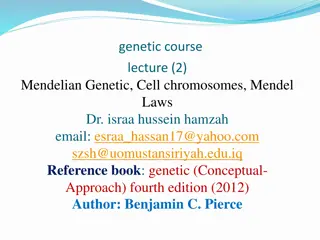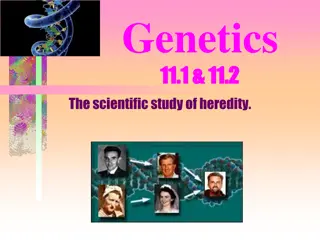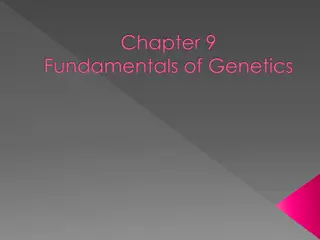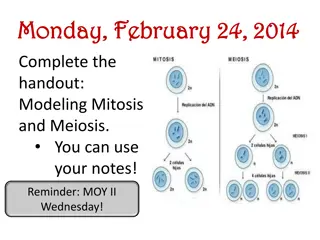Understanding Genetic Patterns Beyond Mendel's Peas
Explore additional genetic patterns such as incomplete dominance, codominance, multiple alleles, and unique inheritance mechanisms like sex-influenced traits and cytoplasmic inheritance. Discover how genes interact to influence traits beyond Mendel's classic experiments, shedding light on the complexities of genetic inheritance.
Download Presentation

Please find below an Image/Link to download the presentation.
The content on the website is provided AS IS for your information and personal use only. It may not be sold, licensed, or shared on other websites without obtaining consent from the author. Download presentation by click this link. If you encounter any issues during the download, it is possible that the publisher has removed the file from their server.
E N D
Presentation Transcript
Additional Genetic Patterns Other Patterns Incomplete Dominance Codominance Lethal Alleles Hierarchy of Dominance Multiple Alleles Mendel s peas Complete Dominance Two alleles per gene One gene affects one trait Many traits (Pleiotropy) Two (or more) genes affect one trait (Gene Interactions and Polygenic Traits)
Additional Genetic Patterns Other Patterns Sex-influenced traits Sex-limited traits Cytoplasmic Inheritance Genetic Maternal Effect Genomic Imprinting Anticipation Mendel s peas Could not observe gender-specific traits Equal contributions from both parents Trait expressed at same level and stage of life No environmental influence Environmental Effects
Incomplete Dominance Incomplete dominance: neither allele masks the other and both are observed as a blending in the heterozygote RR x R R Red White Four o clock flowers R = red, R = white RR pink
Incomplete Dominance RR x RR Pink x Pink Genotypic Ratio: Phenotypic Ratio:
Multiple Alleles Multiple alleles: three or more alleles exist for one trait (Note: A diploid individual can only carry two alleles at once.) Blood Type Type A Type B Type O Allele IA IB i
Codominance Codominance: Neither allele masks the other so that effects of both alleles are observed in heterozygote without blending IA = IB > i IA and IBare codominant. IA and IBare completely dominant over i.
Codominance Phenotype Genotype Gene Antibodies Present Product Antigen A Antigen B Antigen A and Antigen B none Type A Type B Type AB IAIAor IAi IBIBor IBi IAIB Anti-B Anti-A Neither Anti-A nor Anti-B Anti-A and Anti-B Type O ii
Antigens on Red Blood Cells I I Ai Bi I A I B
Inheritance of Rh Factor Phenotype Genotype* Gene Antibodies Present Product Rhesus Protein None None Rh Positive Rh Negative rr RR or Rr None unless exposed *There are multiple alleles for the Rhesus protein (R1, R2, R3, etc.) and all are dominant to the multiple alleles for the absence of Rhesus protein (r1, r2, r3, etc.) .
Multiple Alleles and Codominance Type A, Rh positive x Type B, Rh negative (father is Type O, Rh negative) (mother is Type O) Phenotypic Ratio of Offspring
Lethal Alleles Example: Manx cat ML= tailless, lethal in homozygote m = tail Tailless male x Tailless female
Hierarchy of Dominance Example: hair curling Sw= wooly Sc= curly Swa= wavy s = straight Sw>Sc> Swa>s
Hierarchy of Dominance Dad Colavito has wavy hair. Mom Colavito has curly hair. Their daughter Jean has straight hair. What are the expected genotypic and phenotypic ratios for their offspring? Sw>Sc> Swa>s
Hierarchy of Dominance Dad C x Mom C Wavy Curly Sw> Sc> Swa>s Bonus: What is Dr. C s genotype?
Pleiotropic Effects One gene affects many phenotypic characteristics Allele S S Gene Product Hemoglobin A Hemoglobin S Cell Shape Round Sickled under low O2tension Resistant in SS genotype Response to Malaria Susceptible
Example of Polygenic Inheritance Two genes affecting skin coloration % Pigmentation Number of Dominant Alleles 0 Skin Color* (Phenotype) Genotypes White aabb 0-11% 1 Light Black Aabb or aaBb 12-25% 2 Medium Black AAbb or AaBb or aaBB Dark Black AABb or AaBB 26-40% 3 41-55% 4 Darkest Black AABB 56-78% *Based on a study conducted in Jamaica.
Polygenic Inheritance Medium Black Woman (mother is white) X Darkest Black Man
Interacting Genes Affecting a Single Characteristic eg. Skin coloration in snakes One gene O = orange pigment o = no orange pigment Second gene B= black pigment b = no black pigment
Interacting Genes Affecting a Single Characteristic eg. Skin coloration in snakes Oo Bb x Oo Bb OB Ob o b o B OO BB OOBb Oo BB Oo Bb OB OO Bb OO bb Oo Bb Oo bb Ob o o Bb Oo BB Oo Bb o o BB o B Oo b b Oo Bb o o Bb o o b b o b
Interacting Genes Affecting a Single Characteristic eg. Skin coloration in snakes OoBb x OoBb 9/16 O_B_ 3/16 O_bb 3/16 ooB_ 1/16 oobb
Epistasis An allele of one gene masks the expression of alleles of another gene and expresses its own phenotype instead. Gene that masks = epistatic gene Gene that is masked = hypostatic gene Genes that code for enzymes that are upstream in a biochemical pathway usually exert epistasis ( standing on ).
Recessive Epistasis Epistatic gene exerts its affect with homozygous recessive genotype. eg. Petal color in blue-eyed Mary plants mm= magenta, ww =white, W__M__= blue W M enzyme 1 enzyme 2 Precursor 1? anthocyanin colorless Precursor 2? blue magenta
Recessive Epistasis eg. Petal color in blue-eyed Mary plants Ww Mm x Ww Mm 9/16 W__ M__ 3/16 W __ mm 3/16 w w M__ 1/16 w w mm Phenotypic ratio:
Duplicate Recessive Epistasis Defective products of recessive alleles of two different genes interfere with separate steps in a biochemical pathway. eg. Petal color in harebell flowers ww = white, bb = white, W_ B_ = blue W B enzyme 1 enzyme 2 Precursor 1? anthocyanin colorless Precursor 2? blue colorless
Duplicate Recessive Epistasis eg. Petal color in harebell flowers Ww Bb x Ww Bb 9/16 W__B__ 3/16 W __b b 3/16 w w B__ 1/16 w w bb Phenotypic ratio:
Dominant Epistasis Epistatic gene exerts its affect with the presence of a dominant allele. eg. Fruit color in summer squash Y = yellow, yy = green; W inhibits either color = white; w has no effect on color
Dominant Epistasis eg. Fruit color in summer squash Ww Y y x Ww Y y 9/16 W__ Y__ 3/16 W __ yy 3/16 w w Y__ 1/16 w w yy Phenotypic ratio:
Duplicate Dominant Epistasis eg. Fruit shape in Shepherd s purse A_ or B_ = heart shape aa and bb = narrow shape
Duplicate Dominant Epistasis eg. Fruit shape in Shepherd s purse A_ or B_ = heart aa and bb = narrow A a Bb x A a Bb 9/16 A__B__ 3/16 A__b b 3/16 aa B__ 1/16 aa b b Phenotypic ratio:
Interaction between Sex and Heredity Sex-influenced characteristic Determined by autosomal genes Expression differs by gender John Adams John Quincy Adams Male pattern baldness Dominant in males, recessive in females
Interaction between Sex and Heredity Sex-limited characteristic Determined by autosomal genes Expressed only in one gender Cock-feathered male Hen-feathered female Hen-feathered male Cock feathering, autosomal recessive Expressed only in males
Interaction between Sex and Heredity Cytoplasmic Inheritance Genes found on chromosomes of cytoplasmic organelles Inherited from the maternal parent due to contribution of cytoplasm in ovum Leaf variegation caused by inheritance of variable chloroplast genotypes
Interaction between Sex and Heredity Genetic Maternal Effect Phenotype of offspring depends on genotype of the maternal parent Direction of snail shell coiling is determined by genotype of female parent
Interaction Between Sex and Heredity Genomic Imprinting Expression of autosomal genes differs depending on whether they are inherited from the male or female parent Angelman Syndrome Deletion on chromosome 15 inherited from mother Prader-Willi Syndrome Deletion on chromosome 15 inherited from father
Anticipation Trait is more strongly expressed or expressed earlier in succeeding generations Huntington Disease Increase in number of trinucleotide repeats in gene for protein Huntingtin leads to lethal neurodegenerative disorder with personality changes and uncontrollable movements. Number of repeats expands with succeeding generations. Disease occurs earlier and is more severe.
Expansion of the Trinucleotide Repeat for Huntingtons Disease Linda (6,22) Allen (46,13) age 50 Jama (7,18) Andrew (69,6) age 37 Kristen (64,22) age 40 Ann (64,22) age 39 Bill (8,12) Greg (11,19) Debbie (13,6) Christina (93,7) age 26 Joseph (7,6) Nathaniel (72,19) age 35 Paula (13,12) Evan (not tested)
Environmental Effects Phenotype is dependent upon the presence of a specific environment. The temperature-sensitive product of the himalayan allele is inactivated at high temperatures.
Penetrance and Expressivity Penetrance = percentage of individuals with a given genotype who exhibit the phenotype Expressivity = extent to which genotype is expressed at the phenotypic level (may be due to allelic variation or environmental factors)
